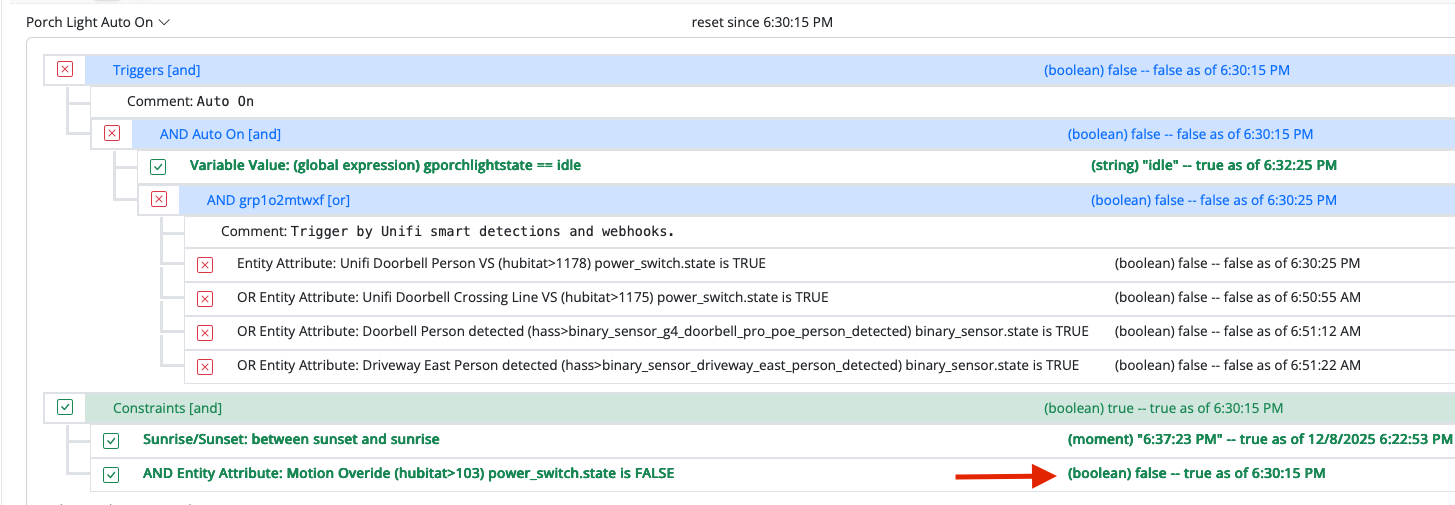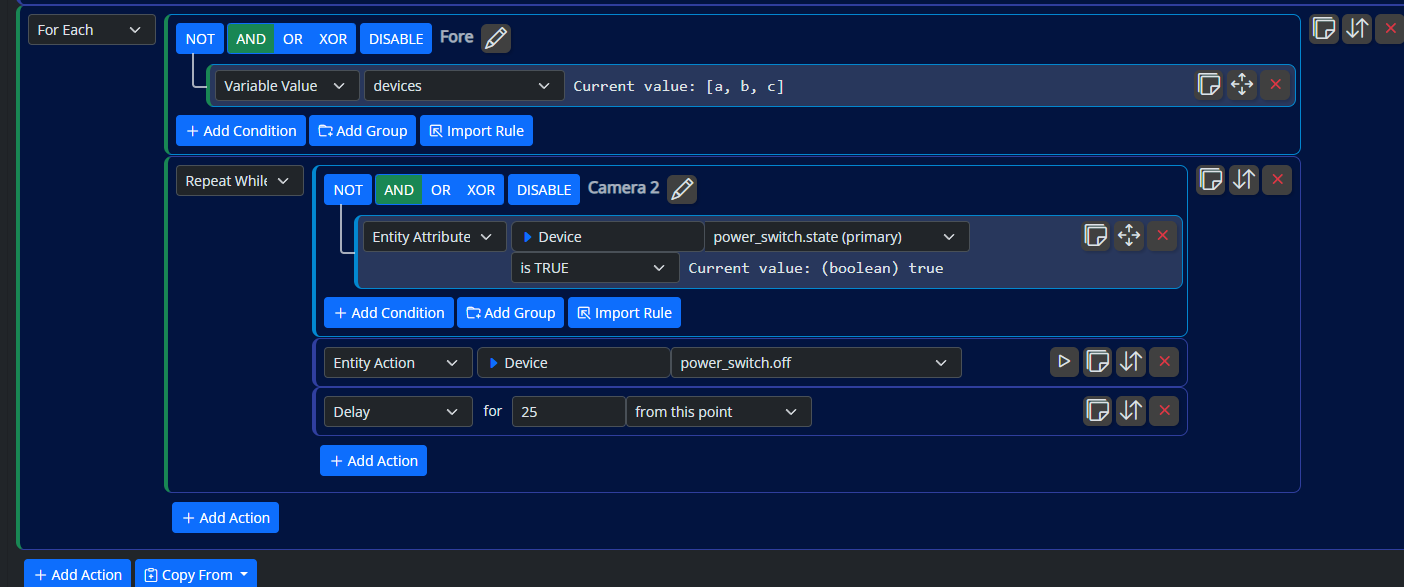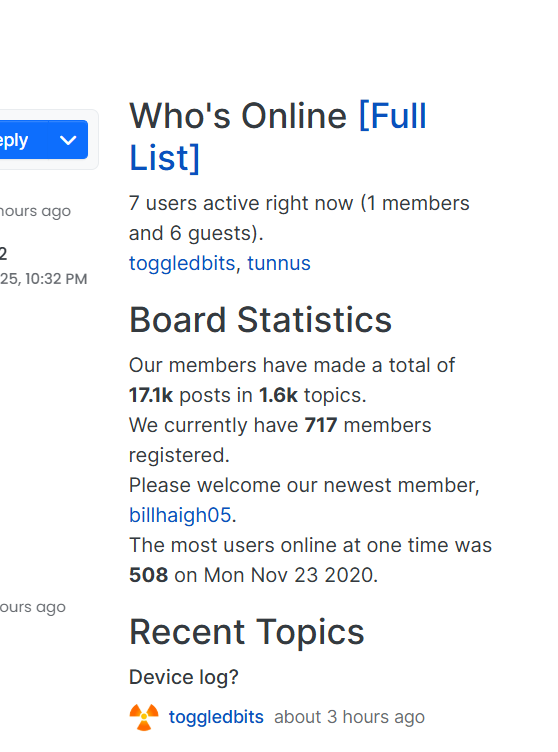I'm sure this has been asked, and answered, but damned if I can figure it out
Use case: I have a rear garden with lights. A door from the kitchen into the garden and a door from the garage.
Currently if I open the kitchen door the lights come on (yay) and a 3 minute delay starts.
After 3 minutes, no matter what else happens, the lights go off (Boo! But also yay!)
What I would like is for the 3 minute delay until the lights go off to start from the latest door open event.
That is, if I'm going from kitchen to garage, and back again, the lights stay on until there's three minutes of no activity.
I've tried 'hacking' with a virtual switch, but can't seem to stop the delay.
Any pointers?
TIA
C
Just for the record, in case anyone is following, I'm really rather impressed.
I have installed one of these:
https://www.amazon.co.uk/dp/B0B6P22YJC?ref=ppx_yo2ov_dt_b_fed_asin_title&th=1
That's connected (physically) to the VM running on my Synology, with a 2m USB extension.
The same host also runs Openluup, Mosquito, HA Bridge.
Yesterday I installed Zigbee2mqtt. That was a bit of a PITA but mostly because of ports and permissions.
Once up and running, and the correct boxes ticked, immediately visible in Home Assistant via the MQTT integration, and thence into Reactor
I've only got two devices. I bought the cheapest sensor I could find, which is a door sensor. Dead easy to add to ZIgbee2mqtt and again, immediately visible in HA.
https://www.amazon.co.uk/dp/B0FPQLWRW1?ref=ppx_yo2ov_dt_b_fed_asin_title
The dongle is on the top floor of the house, and I wanted the sensor on the back door (just about as far apart as it's possible to get short of going into the garage) When I moved the sensor downstairs it dropped out pretty instantly (which wasn't a huge surprise) so quick bit of research found out that smart plugs will act as routers so...
https://www.amazon.co.uk/dp/B0FDQDPGBB?ref=ppx_yo2ov_dt_b_fed_asin_title
Took me about 30 seconds to connect. Updated the name. Instantly visible in Reactor with the new name pushed over from Zigbee2mqtt.
And lo, the door sensor now has a signal of 140 and works as far as I can tell perfectly and instantly (unlike my z-wave one).
A few more of those will be purchased and used to replace the Tuya wifi cloud devices and the (continually failing) Z-wave plugs (yeah, they were TKB so....)
Commended to the house. Thanks for everyone that got me on the right lines.
C
Hello oh great ones.
After a couple of hours messing with ports and permissions I have Zigbee2mqtt installed and running on my virtual pi
Can connect to the front end and everything
Odd one though, simply cannot get systemctl to work and the error is, well, unhelpful. The service file is this:
[Unit]
Description=zigbee2mqtt
After=network.target
[Service]
Environment=NODE_ENV=production
Type=notify
ExecStart=/usr/local/bin/node index.js
WorkingDirectory=/opt/zigbee2mqtt
StandardOutput=inherit
# Or use StandardOutput=null if you don't want Zigbee2MQTT messages filling syslog, for more options see systemd.exec(5)
StandardError=inherit
WatchdogSec=10s
Restart=always
RestartSec=10s
User=pi
[Install]
WantedBy=multi-user.target
Straight out of the docs with the change to point to my local node install (which we know works as it's the same as the very fine Reactor is using.
Running manually pnpm start
in /opt/zigbee2mqtt works fine
However:
catman@openluup:/etc/systemd/system$ sudo systemctl start zigbee2mqtt.service
Job for zigbee2mqtt.service failed because the control process exited with error code.
See "systemctl status zigbee2mqtt.service" and "journalctl -xe" for details.
Which I have
catman@openluup:/etc/systemd/system$ sudo systemctl status zigbee2mqtt.service
● zigbee2mqtt.service - zigbee2mqtt
Loaded: loaded (/etc/systemd/system/zigbee2mqtt.service; disabled; vendor preset: enabled)
Active: activating (auto-restart) (Result: exit-code) since Tue 2025-12-16 12:32:42 GMT; 4s ago
Process: 3093 ExecStart=/usr/local/bin/node index.js (code=exited, status=217/USER)
Main PID: 3093 (code=exited, status=217/USER)
and
-- A start job for unit zigbee2mqtt.service has begun execution.
--
-- The job identifier is 17477.
Dec 16 12:35:16 openluup systemd[3178]: zigbee2mqtt.service: Failed to determine user credentials: No such process
Dec 16 12:35:16 openluup systemd[3178]: zigbee2mqtt.service: Failed at step USER spawning /usr/local/bin/node: No such process
-- Subject: Process /usr/local/bin/node could not be executed
-- Defined-By: systemd
-- Support: https://www.debian.org/support
--
-- The process /usr/local/bin/node could not be executed and failed.
--
-- The error number returned by this process is ERRNO.
Dec 16 12:35:16 openluup systemd[1]: zigbee2mqtt.service: Main process exited, code=exited, status=217/USER
-- Subject: Unit process exited
-- Defined-By: systemd
-- Support: https://www.debian.org/support
--
-- An ExecStart= process belonging to unit zigbee2mqtt.service has exited.
--
-- The process' exit code is 'exited' and its exit status is 217.
Dec 16 12:35:16 openluup systemd[1]: zigbee2mqtt.service: Failed with result 'exit-code'.
-- Subject: Unit failed
-- Defined-By: systemd
-- Support: https://www.debian.org/support
--
-- The unit zigbee2mqtt.service has entered the 'failed' state with result 'exit-code'.
Dec 16 12:35:16 openluup systemd[1]: Failed to start zigbee2mqtt.
-- Subject: A start job for unit zigbee2mqtt.service has failed
-- Defined-By: systemd
-- Support: https://www.debian.org/support
--
-- A start job for unit zigbee2mqtt.service has finished with a failure.
Which strikes me as very odd.
Any blindingly obvious things I'm missing?
TIA!
C
Obviously a quiet forum, but perhaps it's time
I'm looking at rolling Zigbee into my system, in large part for the Aqara FP300 presence sensors which seem to finally provide a solution to if the wasp is actually in the box.
My current set up is as follows:
One Debian VM on Synology NAS running:
Z-wave Server
Open Luup
Multi system reactor
HA bridge
Mosquito MQQT broker
This machine has a UZB Z-wave stick connected via the USB port on the NAS
Another HAOS VM on the same NAS running HAOS
I've got some older Z-wave stuff that I keep around until it fails.
I have some Tuya stuff integrated in HA
My thought was to get either a SMLIGHT SLZB-06M
or an Aqara Hub M2
Integrate them via Zigbee2MQQT (running on the Debian machine) and then expose them in HA so I can continue to automate in MSR.
Thoughts on which of those devices wold be preferable long term. Both are POE capable which is good. It also appears I could add a USB dongle to the NAS and expose it to the HAOS machine.
Any thoughts from the assembled experts here? TIA
C
Another question to the hive mind. Prompted by the fact that I lost yet another z-wave device over the weekend due to a power issue. It looks like z-way server is reporting another device failed (although it's working fine) and message queue is far too long IMHO. Also the failed device has been removed in the expert interface, but still there in the 'normal' one. Sigh.
Currently I have z-wave, Tuya, thinking about Zigbee.... Does anyone use one single protocol for everything? Right now I'm feeling that as the z-wave stuff dies, I'm just gonna replace it with something else....
C
Not really Smart Home stuff, but going to ask as we have smart people...
Bear with me on this one. Asking here because of the font of knowledge!
For many eek years I have had a Virgin V6 box and a Raspberry Pi running Kodi connected to my TV through a cheap *** HDMI switch. It all worked beautifully but the absolutely critical thing was that the TV remote passed the signals back to the Pi to allow remote control of Kodi.
Couple of changes of late:
Installed a soundbar on the TV using the ARC (audio return channel). That then turns the soundbar on and off when the TV turns on and off and the TV volume control controls the soundbar volume direct.
Everything continues to work
Upgraded the software of the Tivo box to Virgin 360. This is literally software only. You get sent a snacky new Bluetooth remote hit 'upgrade' on the screen and off it goes.
Now, things are not playing well. Typically when I turn on to watch Kodi the soundbar comes on (as it should) but the TV either puts out sound through its own speakers and the soundbar, or just the soundbar. It's not possible to control the volume of the soundbar through the TV. Also it's not longer possible to control Kodi using the TV remote.
If I turn the TV360 box off, i.e. power it down, before turning on to watch Kodi, everything is fine.
This makes little to no sense to me. My assumption is that the cheap *** HDMI switch is getting something from the TV360 connection that it didn't used to get when the software was Tivo and that's screwing up the HDMI communications. I'm upgrading the switch to something a little less chap, but wondered if anyone could validate my theory at all?
TIA
C
at _ClientAPI._commandTimeout (http://192.168.1.100:8111/client/ClientAPI.js:807:179
Seeing this randomly when returning to open browser tab after being away awhile. Once, maybe twice a day.
"What did you do to trigger it?" Literally nothing, just walked away and returned and there it was.
Actions taken in reasonably close proximity to this particular instance of it popping up: I'd restarted the MSR container in Portainer.
I'll try to grab some logs here shortly.
I'm having an issue with MSR's UI being very unresponsive. It started happening a couple days ago and I didn't make any changes that would have caused this except adding some meross lan devices in HA. When I go into an entity action and use the search functionality, it usually will start filtering and then get to a place after a few letters are entered where it will take 30 seconds or more (sometimes minutes) for the UI to show what I am typing. During this time MSR ui is completely unresponsive. I've tried multiple browsers and multiple computers. HA and MSR are both deployed in docker. I have run HTOP on the host and when the problem happens there are no CPU/Memory spikes at all.
From a functionality standpoint MSR is working perfectly. This seems to be an UI issue only.
Do i need to ditch Docker and run MSR on a Proxmox VM? I have both stand alone Docker and Proxmox environments. I dont mind doing that I just want to be able to use the UI again...
Installation method
Home Assistant Container
Core
2025.7.3
Frontend
20250702.3
nothing crazy in the logs except some openweather map stuff that doesn't make any sense as it is working fine in MSR
Any help would be greatly appreciated
Reactor latest-25328-b2ed1365 app 25328 configuration from /var/reactor/config
NODE_PATH /opt/reactor:/opt/reactor/node_modules
[latest-25328]2025-11-30T20:01:53.843Z <app:null> Reactor build latest-25328-b2ed1365 starting on v24.11.1 /usr/local/bin/node
[latest-25328]2025-11-30T20:01:53.844Z <app:null> Process ID 1 user/group 0/0; docker; platform linux/x64 #161-Ubuntu SMP Tue Jul 22 14:25:40 UTC 2025; locale (undefined)
[latest-25328]2025-11-30T20:01:53.844Z <app:null> Basedir /opt/reactor; data in /var/reactor/storage
[latest-25328]2025-11-30T20:01:53.844Z <app:null> NODE_PATH=/opt/reactor:/opt/reactor/node_modules
[latest-25328]2025-11-30T20:01:53.865Z <app:null> Resolved timezone=America/New_York, environment TZ=America/New_York; offset minutes from UTC=-300
[latest-25328]2025-11-30T20:01:53.867Z <default:null> Module i18n v25141
[latest-25328]2025-11-30T20:01:53.867Z <app:null> Configured locale (undefined); selected locale(s) en-US.UTF-8
[latest-25328]2025-11-30T20:01:53.879Z <app:null> Loaded locale en-US for en-US
[latest-25328]2025-11-30T20:01:53.879Z <app:null> Local date/time using configured timezone and locale formatting is "11/30/2025, 3:01:53 PM"
[latest-25328]2025-11-30T20:01:53.889Z <Structure:null> Module Structure v25326
[latest-25328]2025-11-30T20:01:53.890Z <Capabilities:null> Module Capabilities v24312
[latest-25328]2025-11-30T20:01:53.904Z <Plugin:null> Module Plugin v25141
[latest-25328]2025-11-30T20:01:53.923Z <Timer:null> Module Timer v25279
[latest-25328]2025-11-30T20:01:53.924Z <TimerBroker:null> Module TimerBroker v25314
[latest-25328]2025-11-30T20:01:53.927Z <Entity:null> Module Entity v25251
[latest-25328]2025-11-30T20:01:53.929Z <Controller:null> Module Controller v25253
[latest-25328]2025-11-30T20:01:53.930Z <AlertManager:null> Module AlertManager v25318
[latest-25328]2025-11-30T20:01:53.937Z <default:null> Module Ruleset v25283
[latest-25328]2025-11-30T20:01:53.937Z <default:null> Module Rulesets v25141
[latest-25328]2025-11-30T20:01:53.942Z <GlobalExpression:null> Module GlobalExpression v25258
[latest-25328]2025-11-30T20:01:53.953Z <Predicate:null> Module Predicate v25328
[latest-25328]2025-11-30T20:01:53.956Z <Rule:null> Module Rule v25323
[latest-25328]2025-11-30T20:01:53.958Z <GlobalReaction:null> Module GlobalReaction v25292
[latest-25328]2025-11-30T20:01:53.959Z <Engine:null> Module Engine v25325
[latest-25328]2025-11-30T20:01:53.964Z <httpapi:null> Module httpapi v25328
[latest-25328]2025-11-30T20:01:53.972Z <wsapi:null> Module wsapi v25328
[latest-25328]2025-11-30T20:01:53.994Z <TaskQueue:null> Module TaskQueue 24138
[latest-25328]2025-11-30T20:01:53.994Z <VeraController:null> Module VeraController v25141
[latest-25328]2025-11-30T20:01:54.179Z <HassController:null> Module HassController v25325
[latest-25328]2025-11-30T20:02:13.797Z <OWMWeatherController:null> Module OWMWeatherController v25268
[latest-25328]2025-11-30T20:02:13.800Z <SystemController:null> Module SystemController v25323
[latest-25328]2025-11-30T20:02:13.807Z <MQTTController:null> Module MQTTController v22092
[latest-25328]2025-11-30T20:02:20.630Z <OWMWeatherController:CRIT> FetchError: request to https://api.openweathermap.org/data/2.5/weather?lat=xxxxxxxxxx&lon=-xxxxxxxxx&appid=xxxxxxxxxxxxxxxxxxxxxxxxxx&units=standard&_r=1xxxxxxxxxxxxxxfailed, reason: [-]
FetchError: request to https://api.openweathermap.org/data/2.5/weather?lat=xxxxxxxxxxx&lon=-xxxxxxxxxxxxxxxxxx&appid=xxxxxxxxxxxxxxxxxxx&units=standard&_r=xxxxxxxxxxxxxxxfailed, reason:
at ClientRequest.<anonymous> (/opt/reactor/node_modules/node-fetch/lib/index.js:1501:11)
at ClientRequest.emit (node:events:508:28)
at ClientRequest.emit (node:domain:489:12)
at emitErrorEvent (node:_http_client:108:11)
at TLSSocket.socketErrorListener (node:_http_client:575:5)
at TLSSocket.emit (node:events:508:28)
at TLSSocket.emit (node:domain:489:12)
at emitErrorNT (node:internal/streams/destroy:170:8)
at emitErrorCloseNT (node:internal/streams/destroy:129:3)
at processTicksAndRejections (node:internal/process/task_queues:89:21
Build 21228 has been released. Docker images available from DockerHub as usual, and bare-metal packages here.
Home Assistant up to version 2021.8.6 supported; the online version of the manual will now state the current supported versions;
Fix an error in OWMWeatherController that could cause it to stop updating;
Unify the approach to entity filtering on all hub interface classes (controllers); this works for device entities only; it may be extended to other entities later;
Improve error detail in messages for EzloController during auth phase;
Add isRuleSet() and isRuleEnabled() functions to expressions extensions;
Implement set action for lock and passage capabilities (makes them more easily scriptable in some cases);
Fix a place in the UI where 24-hour time was not being displayed.








